
|
 |

|
 |
Aditi Mangaldas: COVID has forced us to re-skill ourselves - Shveta Arora e-mail: arorashveta1806@gmail.com September 28, 2021 February 2020 was the month when the news of the corona virus in India started trickling in. And in March 2020, India, and much of the rest of the world, went into a state of lockdown. Since then, we have had more lockdowns, new mutations, new spikes in numbers, persisting symptoms, tragic deaths and all hell breaking loose during a devastating 'second wave'. This cruel pandemic has wiped out many, many young, productive lives and destroyed the confidence of many. Without getting into any controversy over how it originated, or how it spread, the politics and the economics of it, there are always some lessons that stay with us after every devastating event if we survive it. We learnt how to stay home, be with our families, do our household chores ourselves, wear double masks, breathe while sweating and choking inside our masks, keep at a distance from all others. No more of those social hugs, get-togethers and muah-muahs. We learnt to isolate ourselves from our families when not well, look after our sick folks on a war footing and then prize our lives if there was a release from the clutches of the Delta variant. And also, to attend prayer meets online, to lose your loved ones to death as if birth and death were a day-to-day business. To try to come to terms if you lost a dear one after a few days of just fever. In worse times, we learnt that doctors and hospitals could not get us out of these situations, oxygen too could be short, ventilators, medicines and doctors, even in today's day and time, could be scarce. We learnt to live in fear of contracting a cold or a cough and be the next morsel for the god of death. But in these dark times too, for an artist, the period of limbo became the time to introspect, to create and to perform just for oneself, view it oneself and then to review it oneself. Many artists and dancers have used technology to create some amazing works of art in Instagram and Facebook videos, stories and reels, live interactions and performances, recorded performances, films etc. - various forms of showcasing their work. If the corporates learnt to work from home, so did the artists. So we thought we would start talking to dancers about how they see the future for themselves and for the performing arts. Aditi Mangaldas shares her thoughts. 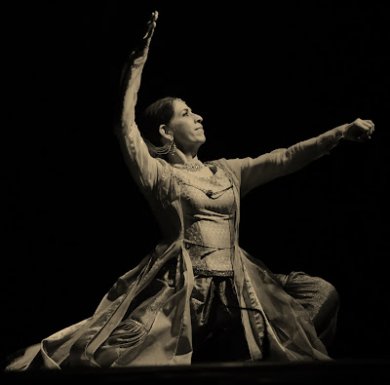 Aditi Mangaldas (Photo: Anoop Arora) The experience of the pandemic has forced the arts to adapt from the stage to online platforms, which are neither as physically expansive nor as intimate as the stage. The two platforms both have their advantages and disadvantages. Do you think the online arrangement will prove to be just a stopgap or will the best of both be brought together as restrictions ease? You know I have always thought that the arts do not exist in a vacuum. Great art responds to the pulse of the now, the breath of the now, whether it is classical, contemporary or popular.The air that you breathe, the emotions coursing through you respond to the now. Art is not merely an interpretation or reflection of what you have learnt over the years. Of course, dance has to be seen live: the sweat, the pulse, the rhythms, the colours. There are no two opinions about that. But in the current situation, that is not the reality anymore. I don't know what it is going to be tomorrow. But it has forced us to re-skill ourselves, to find expansion within constriction, to find a way of expression which I, at least, did not know - how to dance for the lens of the camera, a digital platform, a two-dimensional platform. And it has been a great learning experience to see how many details come into focus. And if at all we go back to the stage, what will the residue of this learning be? This pandemic has been so heart-wrenching and devastating. But one has to try and be creative and positive. As I said, one has to re-skill oneself. I have re-learnt many things. I have learnt what anxiety does to my mind, my body, my movement. I have learnt to respond to the entire world and to nature. As an artist, one has to learn that. Our art then reflects the present, the now, the moment. The exchange between a guru and a shishya, or a mentor/choreographer and a dancer, depends greatly on physical interaction. This was totally eliminated due to social distancing and lockdowns. What would you say to that? If there is a snake in the room, we cannot pretend that it is not there. You have to respond. This is what happened to humanity. Our river was dammed suddenly, and each one of us as artists - or at least I - said, okay, this is the reality. This is what I have and I have to make it work. I don't want to sit and complain and compare and crib, oh, it was like that. I wanted to find my creativity taking into my stride what has happened, and learn from that process. It is not about what is perfect, it is about learning from the journey, the immersion; it is about having that rigour in my body. I always say that dance is bursting from my body and stopping at my skin. In the past months, I have found myself almost exploding. The aim is to still remain immersed in it and to find the vigour and rigour in it. One aim is to learn to find how your mind and body are responding. 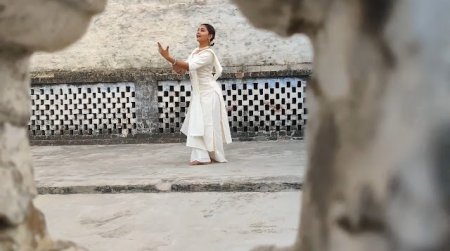 Diksha Tripathi in 'Khidki Se' 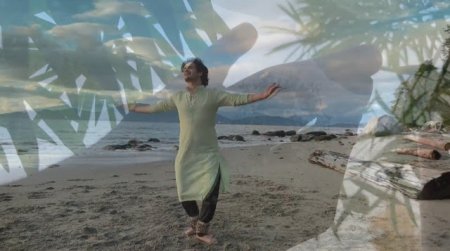 Gaurav SS Bhatti in 'Sparsh' At Drishtikon, we have been constantly engaging in a conscious manner, sharing, from my home to your home, because nothing was fixed. I would make a tukda in the morning and dance it out in the evening, making mistakes, or not making the right moves: this is what I wanted to share about vulnerability, a condition that we were all in. And then we all started making films using our past experiences and the current predicament. Such as Amorphous, One By One, Within From Within - which we did as a fundraiser for underprivileged artists. I have performed on many platforms. In fact, we had a chat series called Imperfect Circles, 27 dancers in conversation with 5 international collaborators whomI have had the privilege of working with. About what is a piece of art and what are the things that make it great. The company has been engaged in making Within From Within. They made their short films from then and now. They visited their older production, Ten By Ten, and made One By One. Recently, they have made Khidki Se, about their experiences during lockdown. I happened to go out only once in the beginning of the second phase and there was so much going around and so much stress. Yet, we could venture out to a studio and we recorded my first solo in the pandemic - Lost In The Forest. We are working on a host of new things. We are doing a social media event called Dance Heals and a workshop spread out across three months. We are also doing a project about getting lawyers and dancers to discuss the legal issues regarding copyright infringement, intellectual property and laws that are enshrined in our Constitution about the rights of artists. Once you know that you are working on something for the camera, as a film or a video, how do you go about the choreography and the concept? In videography, there are many pluses - lights and sounds can be enhanced, images are clearer and can be superimposed, props can be used and highlighted, like the frames you used in one of your productions. Frames can be used even on stage. The eye of the camera is what one has to learn about because that is a specific thing that can come really close to you, it can see a drop of sweat on you, a beetle rocking on a leaf outside, a sunbeam in a different way. That's a learning process. Most of our films were made by us on our phones etc. All the dancers have filmed their own work in Khidki Se. Lost In The Forest was done by a professional photographer and he's actually brilliant because he also dances with the dancer, so the camera moves along with you. The camera is not static, its eye goes to a variety of different places: angle, perspective, fast, slow - that is what one can work on and explore. I don't sit down and say, okay now let's conceptualize (for the camera). All my work, as I say, always has an autobiographical peg - something in my life triggers it - and then I hope it goes on a different journey, that it has a more universal life than one life. Lost In The Forest also began with the sense of having this feeling of amorphousness. Shubha Mudgal sent me one of the most beautiful poems of Kunwar Narayan - Nav Mein Nadiya - everything is so upside down that the river is in the boat, it says. That's where I worked on the empty frames, because they give a sense of lost narrative, lost time, lost space - you don't have to say it. Just looking at an empty frame hanging in the middle of a room, you start questioning: present, past, future, geographies and histories. It's a wonderful metaphor. These frames were part of my lockdown in Bombay for three months. I was trying to find little things in my house to use. 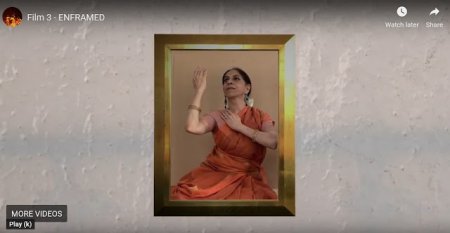 Enframed Last year in March, when it was a complete lockdown, I thought, what do I work with in my home? We found small little objects which we made films with, which was very exciting. I used the frames in Within From Within in a small way, but it had been in my mind. So when I did the film in Delhi, I asked someone to send them to me from Bombay. Even the flower I stuck in my deer piece in my hair had come as part of an arrangement in a plastic bag along with a gift sent to my son just before the lockdown. When I went into lockdown, rehearsals closed. My mother had come in with just one nice sari and I had no flowers in the house. We were not even allowed to go down and anyway, there was so much worry about contact that I was afraid to go down and pick flowers. I had this one plastic flower and I made so much use of it! I floated it in water; I put it in my hair. It's become part of my makeup and jewellery, so I felt really connected to it when dancing the deer piece. I found a way to stick it in my hair so it doesn't fly out. I will have to rethink how to put the frames piece in a live performance because you can't get so close to the frame and go behind it, like the camera can, so we will have to reimagine it for stage. In the film, it gives the impression that somehow, we can bend out of the window and move out - a feeling like we have now. Yes, all these emotions put together -what if that frame represents a period in your life, because you frame paintings, photographs; it's a representation of your emotions and feelings and thoughts and geographic time and memory. But all memories are gone because we are in such a weird place right now. What is your preferred online platform - FB, Instagram? I'm on Instagram, LinkedIn, Twitter and Facebook, and our office is constantly trying to think of interesting things to amplify our presence. Now we are coming up with a special thing just for social media, a project called Dance Heals. Everybody is trying to think of what to do and keep engaged, keep creativity alive and thriving. It's important to have it pulsating and not lose the vigour and rigour required for the type of dance we do. You ticketed shows for stage - are you doing so for online as well?  Aditi Mangaldas (Photo: Anoop Arora) Yes, we are doing nothing free except little clips. But whenever I have been on a platform, I say give money, even if 100 rupees, and give to Drishtikon, not to me. The response is - very difficult. I can't say that we can survive with that, no. It's very difficult to survive on earnings from a digital platform. And the government - forget supporting artists in the first or second wave, they've not even released salary grants owed to us for the past two years. Some of us are very privileged not to be starving. I have the privilege to think about artistic endeavours. But some artists are starving and thinking about where the next meal is coming from. I am very angry about how unconcerned this government is. I feel privileged and grateful that I am able in a position to think of art and dance (not just survival). I also pass through weird phases and you have to just tell yourself stop it, give yourself a slap and come out of it and just get on with life. It's been so bad for some artists. We are not putting out anything for free - everything is ticketed or for a cause - and we are always taking something that goes towards the Drishtikon kitty for the artists, but it is nowhere near enough to support livelihoods. I'm just trying to take my little ship of dancers and musicians across. Things will change eventually, because we can't continue like this. We've also constituted an award in the name of Dr. Sunil Kothari - a very, very small Rs. 11,000 award for the film adjudged the best out of the five dancers and judged by an eclectic jury from across the world. This year, we have done it with our own Drishtikon people, but next year, we will open it out to other dancers and continue to give out a small award in the name of Dr. Kothari because he was very, very helpful to me till the very end. I've known him since I was a little girl. 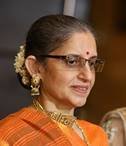 Shveta Arora is a dance-mad writer who chronicles classical dance events in Delhi. Ten years ago, she started the blog Kala Upasana at delhiculturecomment.blogspot.com, where she began posting her own writing along with photographs clicked by Anoop Arora, her husband. She's been dancing all her life as a devotee, but resumed her formal training in Kathak in her 50s and has passed her fourth year Kathak exams. Post your comments Please provide your name and email id when you use the Anonymous / blog profiles to post a comment. All appropriate comments posted with name and email id in the blog will be featured in the site. |